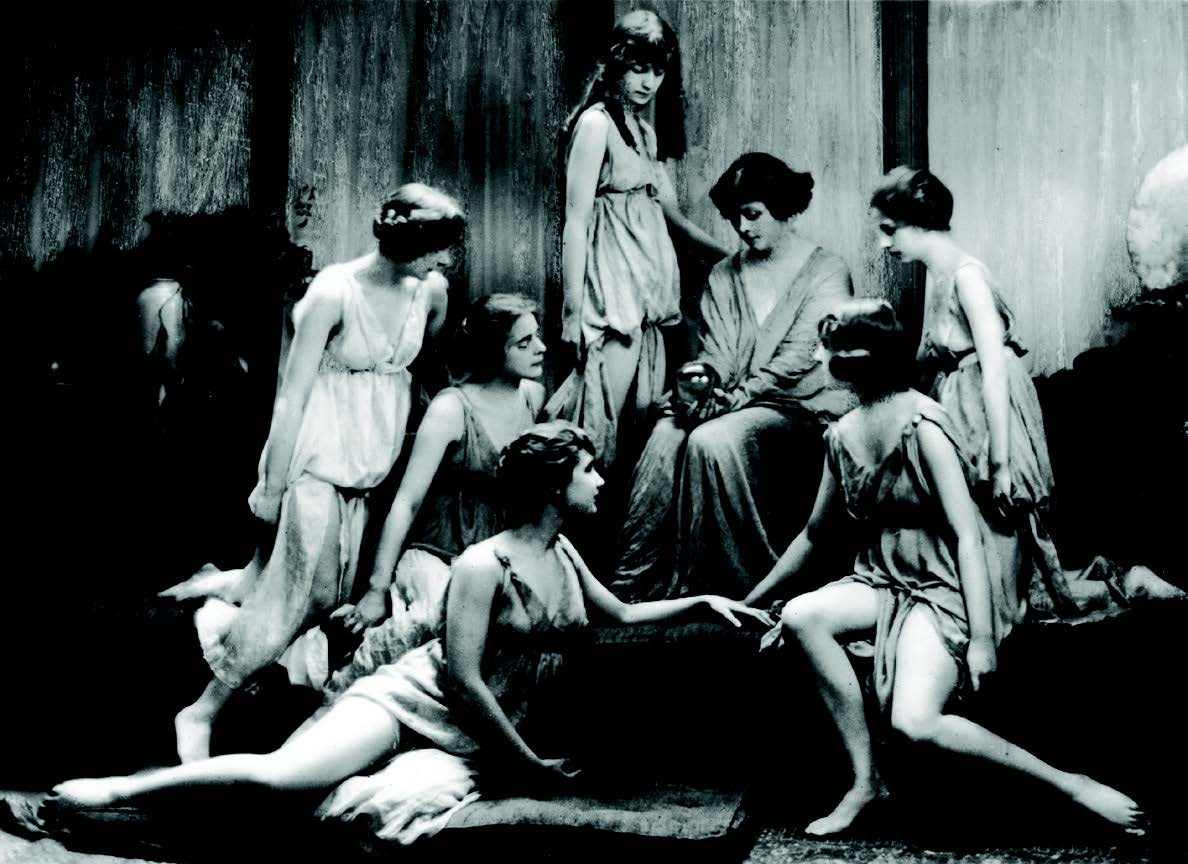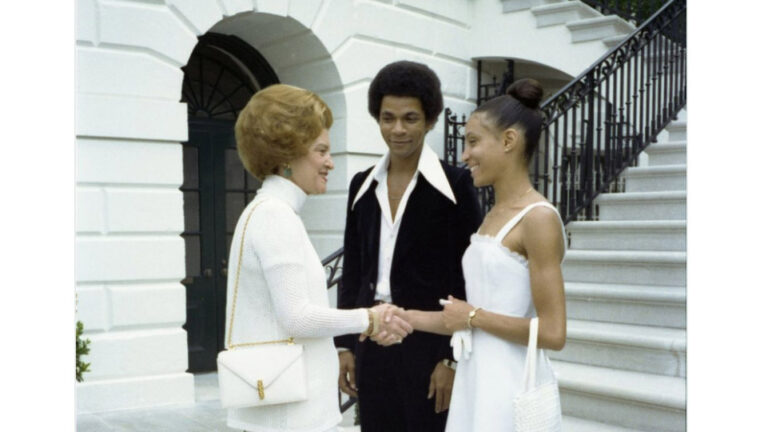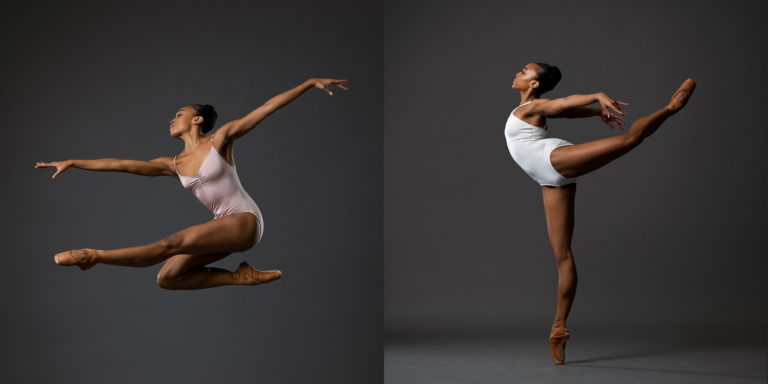
The moment when Isadora Duncan throws her head back in ecstasy as she dances at the Theatre of Dionysus in Greece (preserved in the 1903 photograph above) captures Duncan’s archetypal performance qualities: supple, improvisatory, transcendent. Arguably the most important American-born dance artist of the early 20th century, Duncan forged her style against ballet’s codified technique and its aristocratic lineage. Renouncing typical female dancing roles—such as the coquette, femme fatale and tragic victim of love—the trailblazer expanded women’s possibilities, onstage and off, and helped lay the foundation for American modern dance.
Growing up in San Francisco, Duncan (1877–1927) studied ballet, ballroom and Delsarte gymnastics, which combines a systemized set of gestures and movements with calisthenics. She told audiences, however, she learned to dance by watching the ocean—she felt the tide’s movement corresponded to the lung’s expansion and contraction, which created heaviness and lightness in the body.
At 18, Duncan made her professional debut with a theatrical touring company in Chicago, and a year later she moved to New York City to continue her work on the stage. Chagrined by the lot of American dancers, who were treated as showgirls, not artists, she crossed the Atlantic in 1899 and launched a solo dance career in European salons. Inspired by avatars of individualism—like poet Walt Whitman and philosophers Jean-Jacques Rousseau and Friedrich Nietzsche—she became the author of her own movement, the creator of her own style.
When Duncan was 19, the Olympics were revived and the growing fascination with Greek culture ignited her imagination. Greece was the birthplace of Aristotle, Plato and Western civilization’s ideas about beauty, and she surmised the archipelago must have had a dancing culture that expressed its philosophical and aesthetic ideals. But Greek dance had not survived history. Undeterred, Duncan capitalized on the loss. She cast off the Victorian corset and wore toga-like costumes.

Unconstrained by her dress, her entire body gestured. She shirked ballet’s five positions of the feet for continuous motion, based on walking, skipping, running and leaping. She spurned the idea of physical control, replacing it with corporeal release. The solar plexus—the region between the waist and the sternum—she said, was the wellspring for all movement.
Through Romantic music—Schubert, Chopin, Gluck and Brahms—Duncan’s body resembled a cresting wave, emotion welling up from what she called “the luminous manifestation of the soul.” She didn’t envision her body as being in music’s service; instead, music served as her inspiration.
Ballet choreographer Michel Fokine was especially influenced by Duncan’s work. When he saw her perform to Chopin, he used the composer’s études to create Les Sylphides, the first abstract ballet. Also inspired by Duncan, Fokine choreographed Dying Swan, which uncharacteristically cast Anna Pavlova’s upper body off its central axis, making emotion the ballet’s focus, rather than virtuosity.
But not all artists of the time were accepting of Duncan’s seemingly carefree style. When Vaslav Nijinsky saw her dance, he remarked that the work was not art because it was not based in technique. But she was formulating a codified technique—one very different from classical ballet’s systematic approach.
In the space of two decades, Duncan founded three schools across Europe. The first (established in 1904), in Grunewald, Germany, produced her most celebrated troupe of pupils: the Isadorables, who have helped preserve and disseminate her style of dance. The second (established in 1914) was based in a château outside Paris. Duncan’s last school was founded in 1921 in Moscow, in the wake of the Russian Revolution. It was her most politically ambitious venture: She connected the Bolsheviks’ idea of a classless society and opened her doors to all.
Though all three schools folded within her lifetime, a generation of Duncan dancers was born and her disciples passed down her principles.
“From London to Paris to New York to Santa Barbara, I found that Duncan dancers taught the same plié, swing of the leg, musicality, arm and foot work and placement of the body,” says Lori Belilove, a master teacher and performer who founded the Isadora Dance Foundation. Belilove also notes that all of the dancers’ warm-ups incorporate the rippling of the spine and a specific use of the breath.
Duncan’s personal life was as exceptional as her stage career. She bore two children out of wedlock, saying in her defense, “Any intelligent woman who reads the marriage contract, and then goes into it, deserves all the consequences.” But in 1913, while living in Paris, tragedy struck. A car carrying her two children rolled into the River Seine. Both children drowned. The tragedy drove her to indulge in drink.
In 1922 she married a Soviet poet and rallied to communism. On her second American tour, she spoke to U.S. reporters about the ills of capitalism, and soon she was booed off stages and was forced to cancel the remainder of her tour. Five years later, at 50, Duncan’s life was cut short in Nice, when her long scarf was caught in the spokes of a moving car wheel and strangled her.
Though Duncan never allowed herself to be filmed while dancing, her legacy continues today through the work of Belilove, Jeanne Bresciani (artistic director of the Isadora Duncan International Institute in New York City) and Andrea Mantell-Seidel (former artistic director of the Isadora Duncan Dance Ensemble in Miami). Duncan’s movement principles can be recognized in the works of Doris Humphrey, José Limón and Mark Morris.
“The most important thing about dancing Isadora,” says Belilove, “is to explore an interior depth and send it outward. All the movement starts from an inner motor of feeling.”
Check Out These Resources for Your Students
Books
Done Into Dance: Isadora in America, by Ann Daly (1995)
Duncan Dancer: An Autobiography, by Irma Duncan (1966)
“Isadora Duncan.” International Encyclopedia of Dance, by Susan Manning (1988)
Isadora Duncan, A Sensational Life, by Peter Kurth (2001)
My Life, by Isadora Duncan (1927)
“The Search for Motion.” Time and the Dancing Image, by Deborah Jowitt (1988)
Films
Five Brahms Waltzes in the Manner of Isadora Duncan (Royal Opera House), 2004
Isadora Duncan: Movement from the Soul (Geller and Goldfine, directors), 1990
Reincarnation (Natasha Guruleva, director), 2007
Editor’s note: Lori Belilove & The Isadora Duncan Dance Company will be celebrating Duncan’s 145th Birthday with a Salon performance (livestreamed and in-person) on Friday, May 27 at 7pm ET. The event will honor the Ukrainian people with proceeds going to True Russia charitable organization co-founded by Mikhail Baryshnikov. For more information and to purchase tickets, click here.




